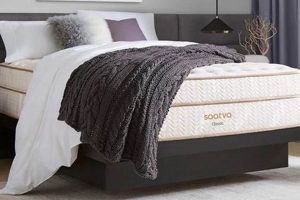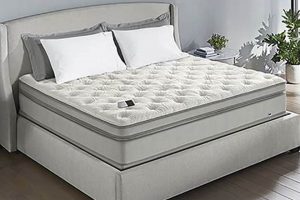The most suitable sleep surface for individuals who primarily rest on their abdomen is a mattress designed to support proper spinal alignment and minimize pressure points. This type of sleep posture often requires a specific firmness level and construction to prevent the sleeper from sinking too deeply into the mattress, which can lead to back pain and discomfort. For example, a mattress that is too soft will allow the midsection to sag, while one that is too firm will create excessive pressure on the ribcage and hips.
Selecting an appropriate sleep surface is paramount for maintaining overall health and well-being. It helps reduce the risk of developing musculoskeletal issues and promotes restful sleep. Historically, stomach sleeping was often discouraged due to potential spinal strain; however, with the advancement of mattress technology and design, suitable options now exist to accommodate this sleep preference while minimizing associated risks.
The remainder of this article will address key factors to consider when selecting a mattress, including firmness levels, material types, construction methods, and specific features that cater to the unique needs of individuals who favor sleeping in a prone position. Understanding these elements is crucial to making an informed purchasing decision and achieving optimal sleep quality.
Guidance for Selecting a Suitable Sleep Surface
The following recommendations provide a framework for evaluating mattresses specifically intended to accommodate individuals who sleep on their stomachs, emphasizing support and comfort.
Tip 1: Prioritize Firmness. A medium-firm to firm mattress is generally preferable. This level of firmness prevents excessive sinking of the midsection, which can lead to spinal misalignment. A too-soft mattress exacerbates this issue, while an overly firm surface can create pressure points.
Tip 2: Consider Hybrid or Innerspring Constructions. Mattresses combining innerspring coils with a comfort layer (such as memory foam or latex) often provide the necessary support and responsiveness. The coils offer underlying support, while the comfort layer provides cushioning.
Tip 3: Evaluate Edge Support. Strong edge support is beneficial, particularly for individuals who tend to sleep near the edge of the mattress. This feature prevents roll-off and ensures consistent support across the entire surface.
Tip 4: Assess Material Breathability. Stomach sleepers can experience increased body heat. Mattresses with breathable materials, such as open-cell foam or coils, promote airflow and help regulate temperature.
Tip 5: Review Spinal Alignment Capabilities. A mattress should facilitate a neutral spinal position. While lying on the stomach, the spine should maintain a relatively straight line, minimizing pressure and strain.
Tip 6: Investigate Mattress Height. A lower profile mattress may be more suitable. A thinner mattress reduces the angle of the neck when stomach sleeping, potentially alleviating neck pain.
Tip 7: Test Before Purchasing. Whenever possible, test the mattress in a similar sleep position before making a final decision. Lie on the stomach for a sustained period to assess comfort and support.
Adhering to these guidelines facilitates the selection of a mattress that promotes spinal health and overall sleep quality for individuals who favor sleeping on their stomachs.
The ensuing sections will delve into specific mattress materials and technologies that align with the aforementioned recommendations.
1. Firmness and Support
Firmness and support are paramount considerations when evaluating a sleep surface intended for those who predominantly sleep on their stomach. The selection of a mattress with inadequate firmness or insufficient support can lead to spinal misalignment, increased pressure points, and diminished sleep quality.
- Spinal Alignment Maintenance
A mattress’s firmness level directly affects the degree to which the spine maintains its natural curvature while lying in a prone position. Insufficient firmness allows the midsection to sink, creating a U-shaped spinal posture that can strain muscles and ligaments. Conversely, excessive firmness may prevent proper contouring, leading to concentrated pressure on the ribcage and pelvic region. The goal is a balanced firmness that supports the body weight without permitting undue sagging.
- Pressure Point Minimization
Adequate support distributes body weight evenly across the mattress surface, mitigating the development of concentrated pressure points. When sleeping on the stomach, areas such as the hips and ribcage are particularly susceptible to increased pressure. A mattress with appropriate support helps to alleviate this pressure, promoting blood circulation and minimizing discomfort. Hybrid mattresses, which combine coil support with comfort layers, can effectively balance support and pressure relief.
- Core Engagement and Posture Control
The level of support offered by a mattress influences the degree of core muscle engagement required to maintain proper spinal alignment during sleep. A mattress that lacks sufficient support necessitates increased effort from the core muscles to stabilize the spine, potentially leading to muscle fatigue and discomfort. A supportive mattress reduces the strain on core muscles, allowing for more relaxed and restorative sleep.
- Long-Term Spinal Health
Consistent use of a mattress that provides insufficient firmness and support can contribute to chronic back pain and other spinal issues over time. The cumulative effect of sleeping in a misaligned posture can lead to structural changes and increased susceptibility to injury. Selecting a mattress that promotes proper spinal alignment is an investment in long-term spinal health and overall well-being.
In summary, the interplay between firmness and support is critical for individuals who prioritize sleeping on their stomachs. By selecting a mattress that provides an optimal balance of these factors, sleepers can minimize spinal strain, reduce pressure points, and promote a more restful and restorative sleep experience. Therefore, focusing on firmness and support is critical when choosing a superior product for stomach sleepers.
2. Spinal Alignment
Maintaining proper spinal alignment is paramount for individuals who sleep on their stomachs, as this position inherently places the spine in a more vulnerable posture. The selection of a sleep surface significantly influences the degree to which the spine can maintain its natural curvature, thereby affecting overall comfort and long-term spinal health. For stomach sleepers, choosing the most suitable mattress necessitates prioritizing spinal alignment as a core criterion.
- Lumbar Support and Sag Prevention
The lumbar region is particularly susceptible to misalignment when sleeping on the stomach. A superior mattress for this sleep style must provide adequate support to prevent the midsection from sagging, which can create an exaggerated spinal curve. The mattress should effectively distribute weight to maintain a relatively straight line from the shoulders to the hips, minimizing strain on the lower back. For example, mattresses with zoned support systems can offer targeted firmness to the lumbar region, enhancing spinal support.
- Neck Strain Reduction
Stomach sleeping often involves turning the head to one side, which can place undue stress on the neck. A mattress that is too thick or firm can exacerbate this issue by elevating the head, increasing the angle of rotation. A lower-profile mattress or one with a softer comfort layer may reduce neck strain by allowing the head to sink slightly, promoting a more neutral neck position. The goal is to minimize the degree of head rotation required for comfortable breathing.
- Shoulder Accommodation and Compression
The shoulders can experience compression when stomach sleeping, particularly on mattresses that lack sufficient contouring. A mattress that effectively conforms to the body’s curves can help alleviate pressure on the shoulders, reducing the risk of discomfort or nerve impingement. Materials like memory foam or latex, known for their pressure-relieving properties, can be beneficial in accommodating the shoulders without compromising spinal support. An optimal mattress design considers the differential pressure exerted by various body parts and distributes it evenly.
- Pelvic Alignment and Hip Support
Proper pelvic alignment is crucial for maintaining overall spinal health. A mattress that supports the hips and prevents them from sinking too deeply into the surface can help ensure that the pelvis remains level, reducing strain on the lower back and hips. Mattresses with reinforced edge support can be particularly helpful in maintaining pelvic alignment, especially for individuals who tend to sleep near the edge of the bed. This feature prevents the hips from sagging, contributing to a more stable and aligned spinal position.
In conclusion, the relationship between spinal alignment and the “best mattress for stomach sleeper” is inextricably linked. The ideal mattress for this sleep position is one that actively promotes and maintains proper spinal alignment, minimizing strain on the lumbar region, neck, shoulders, and hips. By prioritizing spinal alignment as a key criterion, individuals who sleep on their stomachs can significantly improve their sleep quality and reduce the risk of developing long-term spinal issues. Consideration of the previously discussed elements, which includes focused support in various spinal areas, is crucial in this decision-making process.
3. Pressure Relief
Pressure relief is a critical attribute of a mattress designed for stomach sleepers. This sleeping position inherently concentrates body weight onto smaller surface areas, notably the ribcage, hips, and shoulders. A sleep surface incapable of adequate pressure relief can lead to discomfort, restricted blood flow, and disrupted sleep patterns. An appropriate mattress mitigates these issues by evenly distributing weight, thereby reducing stress on these pressure points.
Inadequate pressure relief often manifests as tossing and turning during the night, as the sleeper subconsciously attempts to alleviate discomfort. Over time, sustained pressure can contribute to chronic pain and exacerbate existing musculoskeletal conditions. The importance of pressure relief is exemplified in mattresses incorporating memory foam or latex comfort layers. These materials conform to the body’s contours, minimizing localized pressure. For instance, a stomach sleeper experiencing ribcage pain on a firm innerspring mattress might find significant relief on a memory foam model due to its ability to distribute weight more effectively.
The practical significance of understanding pressure relief in mattress selection for stomach sleepers lies in its direct impact on sleep quality and overall well-being. By prioritizing mattresses with demonstrated pressure-relieving capabilities, stomach sleepers can experience more restful and restorative sleep, reducing the risk of discomfort and promoting long-term spinal health. The optimal choice necessitates a balance between support for spinal alignment and effective pressure distribution to prevent localized discomfort, creating an environment that supports both restful and healthy sleep.
4. Material Breathability
Material breathability represents a critical factor in determining the suitability of a mattress for stomach sleepers. This sleep position often results in increased body contact with the sleep surface, potentially trapping heat and moisture. Mattresses lacking adequate breathability exacerbate this issue, leading to elevated body temperatures, discomfort, and disrupted sleep. Consequently, the selection of a mattress with breathable materials is essential for maintaining thermal regulation and promoting restful sleep. This represents a critical aspect of what constitutes a superior product intended for stomach sleepers.
The impact of material breathability is evident in the performance of various mattress types. For instance, memory foam, while known for its pressure-relieving properties, can sometimes retain heat due to its dense structure. In contrast, innerspring and hybrid mattresses, which incorporate coil systems, often exhibit superior breathability due to the increased airflow within the mattress core. Latex, particularly natural latex with an open-cell structure, offers a balance of pressure relief and breathability. The choice of materials, therefore, directly influences the sleeper’s thermal experience throughout the night. Individuals residing in warmer climates, or those prone to night sweats, should prioritize mattresses with enhanced breathability features. Conversely, individuals residing in colder climates, or those who desire heat retention, may consider a product with slightly reduced airflow.
In summary, material breathability plays a crucial role in optimizing sleep quality for stomach sleepers. The ability of a mattress to dissipate heat and moisture directly affects comfort levels and can prevent sleep disturbances caused by overheating. Prioritizing mattresses with breathable materials, such as open-cell foam, coil systems, or natural fibers, is paramount for individuals who sleep on their stomachs, particularly those sensitive to temperature variations. An understanding of material properties and their impact on airflow is essential for making an informed purchasing decision and promoting restful, temperature-regulated sleep. The integration of breathable material into the sleep surface contributes fundamentally to the broader definition of a superior option for the unique conditions of stomach sleepers.
5. Edge Support
Edge support, often an overlooked feature, holds significant relevance for individuals who favor the stomach sleeping position. The perimeter of a mattress receives concentrated stress, particularly when a sleeper tends to utilize the entire surface area or shares the bed with a partner. Subpar edge support can lead to sagging, reduced usable sleeping space, and compromised spinal alignment.
- Stability and Usable Surface Area
Robust edge support ensures a stable sleeping surface across the entire mattress, preventing the sensation of rolling off the edge. This is particularly crucial for stomach sleepers who may spread out during the night. Strong edges maximize the usable surface area, allowing the sleeper to comfortably occupy the entire mattress width without experiencing a significant change in support or comfort. Without adequate edge support, the mattress perimeter compresses excessively, reducing its effective size and potentially causing the sleeper to shift position involuntarily.
- Enhanced Support for Spinal Alignment
Consistent support across the mattress, including the edges, is essential for maintaining proper spinal alignment. When the mattress edges lack support, the sleeper’s body may tilt or sink towards the perimeter, disrupting the natural spinal curvature. This misalignment can exacerbate existing back pain or contribute to new musculoskeletal issues. Reinforced edge support prevents this tilting effect, providing a more stable and uniform surface that promotes proper spinal alignment throughout the night. For the stomach sleeper, maintaining a relatively straight spinal posture is critical, and strong edge support aids in this objective.
- Durability and Longevity of the Mattress
Strong edge support contributes to the overall durability and longevity of the mattress. Mattresses with weak edges are more prone to sagging and structural damage over time, particularly with repeated use and weight distribution. Reinforced edges help to maintain the mattress’s shape and structural integrity, preventing premature wear and tear. This enhanced durability translates to a longer lifespan for the mattress, making it a more cost-effective investment in the long run. Regular compression and structural compromise degrade a mattress intended for a stomach sleeper.
- Ease of Entry and Exit
While primarily a factor for mobility, the firmness of the mattress edge does help with ease of entry and exit. With strong edge support it is less likely to collapse under the weight of the stomach sleeper when entering and exiting. This can be especially beneficial for individuals with limited mobility, arthritis, or other conditions that make it difficult to get in and out of bed. A firm and stable edge provides a secure surface for pushing off or sitting down, reducing the risk of falls or injuries. This practicality makes the best mattress suitable for individuals of varying physical conditions.
In conclusion, the presence of robust edge support is an important consideration when evaluating what the “best mattress for stomach sleeper” would be. It directly influences stability, usable surface area, spinal alignment, mattress durability, and ease of getting in and out of bed. By prioritizing mattresses with reinforced edges, stomach sleepers can enhance their sleep quality, promote long-term spinal health, and ensure that their mattress provides reliable support for years to come. It enables the full utilisation of the sleep surface.
Frequently Asked Questions
The following questions address common concerns and misconceptions surrounding sleep surfaces and their suitability for individuals who predominantly sleep on their stomachs.
Question 1: Is stomach sleeping inherently detrimental to spinal health?
Stomach sleeping can place increased stress on the spine and neck if the sleep surface lacks adequate support. However, with a properly selected mattress, the risks can be mitigated. A medium-firm to firm mattress, designed to maintain spinal alignment, is recommended.
Question 2: What firmness level is most appropriate for stomach sleepers?
A medium-firm to firm mattress is generally preferable. This firmness level prevents excessive sinking of the midsection, which can lead to spinal misalignment. The precise firmness may vary depending on individual body weight and preferences.
Question 3: Are specific mattress materials better suited for stomach sleepers?
Hybrid mattresses, combining innerspring coils with a comfort layer of memory foam or latex, often provide a balance of support and pressure relief. The coils offer underlying support, while the comfort layer provides cushioning. Latex mattresses, known for their resilience and breathability, can also be suitable.
Question 4: How important is edge support for stomach sleepers?
Edge support is particularly beneficial for individuals who tend to sleep near the edge of the mattress or share the bed with a partner. Strong edge support prevents roll-off and ensures consistent support across the entire surface.
Question 5: Can a pillow be used to improve spinal alignment for stomach sleepers?
A thin pillow or no pillow is generally recommended for stomach sleepers to minimize neck strain. A thick pillow can elevate the head, increasing the angle of rotation and potentially leading to neck pain. Some individuals may find it beneficial to place a thin pillow under the hips to further reduce spinal strain.
Question 6: How often should a mattress be replaced to ensure optimal support?
The lifespan of a mattress varies depending on its construction and materials. However, a mattress should typically be replaced every 7-10 years to ensure adequate support and hygiene. Signs of wear and tear, such as sagging or loss of support, indicate the need for replacement.
Selecting a mattress appropriate for the stomach sleeping position involves careful consideration of firmness, materials, edge support, and pillow selection. Prioritizing spinal alignment and pressure relief is paramount.
The subsequent section will address alternative sleep positions and their corresponding mattress recommendations.
Concluding Remarks on Mattress Selection for Prone Sleepers
This article has explored key considerations in selecting a sleep surface for individuals who predominantly sleep on their stomachs. Emphasis has been placed on the need for adequate firmness to maintain spinal alignment, appropriate materials to facilitate breathability and pressure relief, and robust edge support to ensure a stable and consistent sleep surface. A judicious selection process, accounting for these elements, is critical for maximizing comfort and minimizing potential musculoskeletal issues.
The pursuit of a sleep environment that accommodates the specific needs of prone sleepers represents an investment in long-term health and well-being. Continued research and technological advancements in mattress design offer the potential for further refinement of sleep solutions tailored to this demographic. Individuals are encouraged to thoroughly evaluate their options and prioritize mattresses that demonstrably promote spinal health and restful sleep. The best mattress for stomach sleeper is not merely a purchase, but a commitment to improved health.



![Top-Rated Best Sleeping Mattress for Camping: [Year] Guide Organic & Natural Mattress Buyer’s Guide: Non-Toxic Sleep Solutions Top-Rated Best Sleeping Mattress for Camping: [Year] Guide | Organic & Natural Mattress Buyer’s Guide: Non-Toxic Sleep Solutions](https://mattressworldpa.com/wp-content/uploads/2025/07/th-1737-300x200.jpg)



